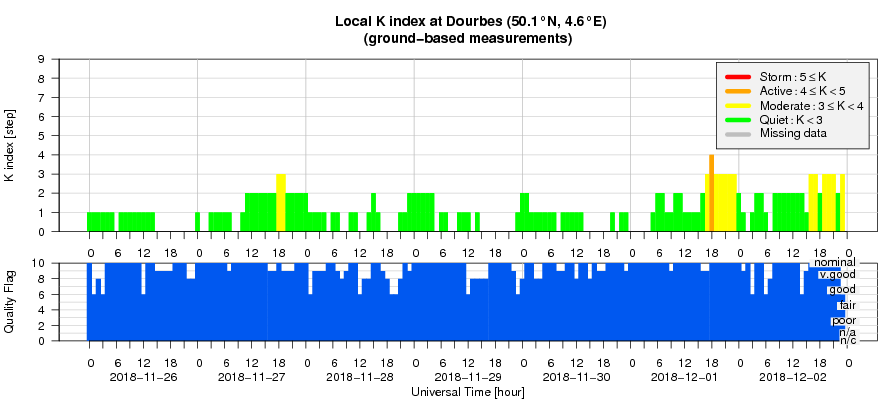- Table of Content
- 1.Space Weather ...
- 2.PROBA2 Observa...
- 3.Review of sola...
- 4.The Internatio...
- 5.Review of geom...
- 6.Geomagnetic Ob...
- 7.Review of iono...
2. PROBA2 Observations (26 Nov 2018 - 2 Dec 2018)
3. Review of solar activity (26 Nov 2018 - 2 Dec 2018)
4. The International Sunspot Number
5. Review of geomagnetic activity
6. Geomagnetic Observations at Dourbes (26 Nov 2018 - 2 Dec 2018)
7. Review of ionospheric activity (26 Nov 2018 - 2 Dec 2018)
Space Weather Introductory Course: post-SWIC
On December 6, while the good behaved children got toys and candy, the NRAF participants got a full day post-SWIC. They were instructed on how the technology they use is impacted by space weather, learned to translate the space weather information into colour maps telling their end-users what they might expect in case of a space weather event.
The STCE also joined for this course.
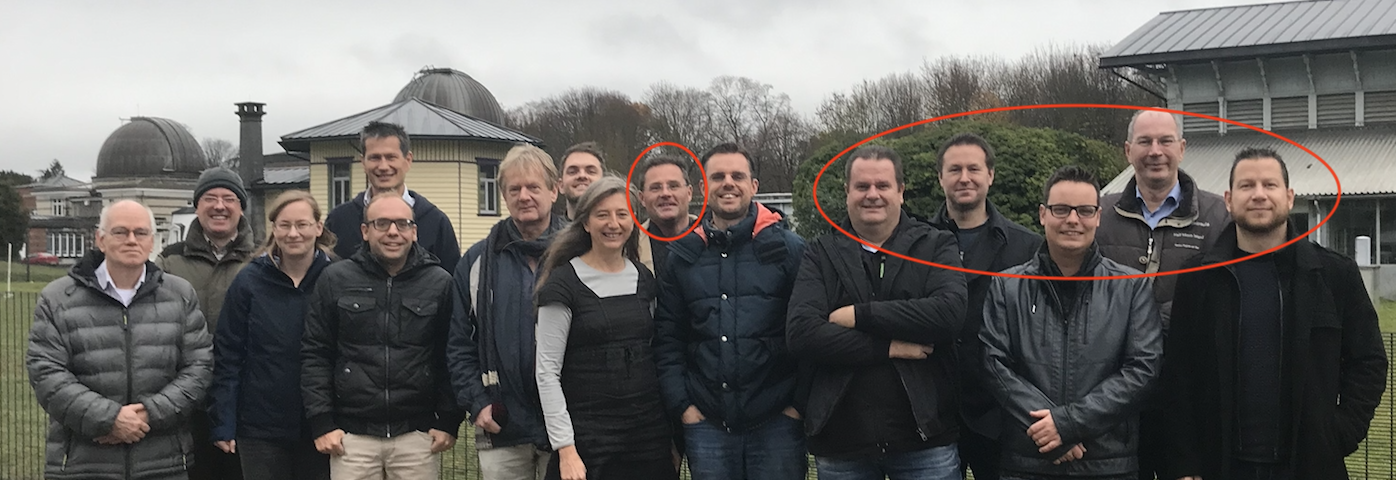
PROBA2 Observations (26 Nov 2018 - 2 Dec 2018)
Solar Activity
Solar flare activity remained very low during the week.
In order to view the activity of this week in more detail, we suggest to go to the following website from which all the daily (normal and difference) movies can be accessed: http://proba2.oma.be/ssa
This page also lists the recorded flaring events.
A weekly overview movie can be found here (SWAP week 453): http://proba2.oma.be/swap/data/mpg/movies/weekly_movies/weekly_movie_2018_11_26.mp4
Details about some of this week's events, can be found further below.
If any of the linked movies are unavailable they can be found in the P2SC movie repository here: http://proba2.oma.be/swap/data/mpg/movies/
Tuesday Nov 27
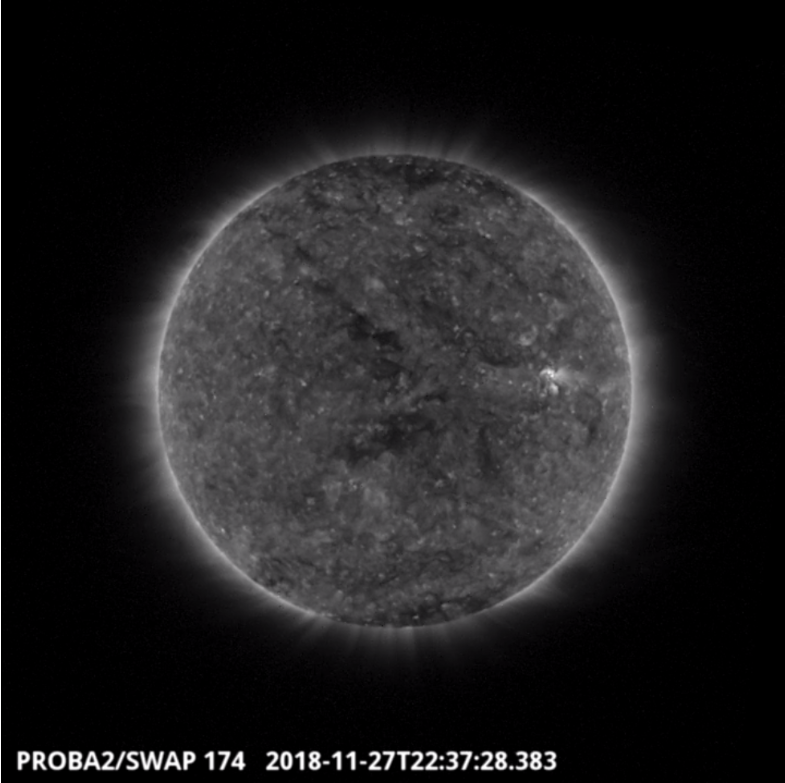
SWAP observed a large equatorial coronal hole, which reached the central meridian on 2018-Nov-27, as shown in the SWAP image above.
Find a movie of the evolution here (SWAP movie): http://proba2.oma.be/swap/data/mpg/movies/20181127_swap_movie.mp4
Review of solar activity (26 Nov 2018 - 2 Dec 2018)
Flares
An active region, NOAA 2728 (no Catania number) emerged near the disk centre on November 25. The region was quiet and disappeared behind the West limb on November 29.
According to the International Sunspot Number (ISN) calculations, the Sun was spotless on November 27, 28, 29, 30. According to the Estimated ISN, the Sun stayed also spotless on December 1 and 2.
Accordingly, flaring activity was extremely low this week with no C-class flares and not even B-class flares reported.
Coronal mass ejections and proton flux
A large prominence, situated close to the southern polar coronal hole, erupted on November 30, around 03:30 UT. The prominence eruption was associated with faint partial halo CME with an angular width around 130 degrees and a projected line of the sight speed around 200 km/s (reported by the CACTUS software). The CME was directed southward from the Sun-Earth line.
The solar proton flux remained at the background level.
Coronal holes
A small equatorial coronal hole with a negative polarity was located in the western solar hemisphere in the beginning of the week.
An equatorial coronal hole of positive polarity reached the central meridian on November 27.
The International Sunspot Number
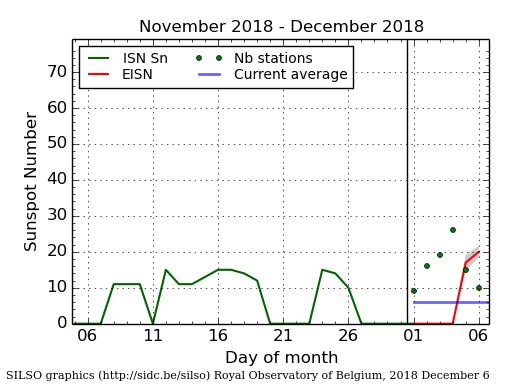
The daily Estimated International Sunspot Number (EISN, red curve with shaded error) derived by a simplified method from real-time data from the worldwide SILSO network. It extends the official Sunspot Number from the full processing of the preceding month (green line). The plot shows the last 30 days (about one solar rotation). The horizontal blue line shows the current monthly average, while the green dots give the number of stations included in the calculation of the EISN for each day.
Review of geomagnetic activity
At L1
The solar wind speed was below 450 m/s, the interplanetary magnetic field magnitude below 10 nT.
The signatures of the small negative coronal hole and the equatorial positive coronal hole were visible in the solar wind measurements by DSCOVR in L1 on November 27 and on December 01, respectively.
The most pronounced signature was associated with the second coronal hole which was at the central meridian on November 27. On December 01, around 01:00 UT, the interplanetary magnetic field magnitude increases simultaneously with the density. At 10:00 UT the solar wind speed (to speeds of 450 km/s) and temperature increased, the density decreased accordingly.
Geomagnetic conditions
The geomagnetic conditions were quiet to unsettled, with only two intervals of disturbed geomagnetic conditions, local station at Dourbes reported K=4 on December 01 and NOAA reported Kp=4 on December 02.
Review of ionospheric activity (26 Nov 2018 - 2 Dec 2018)
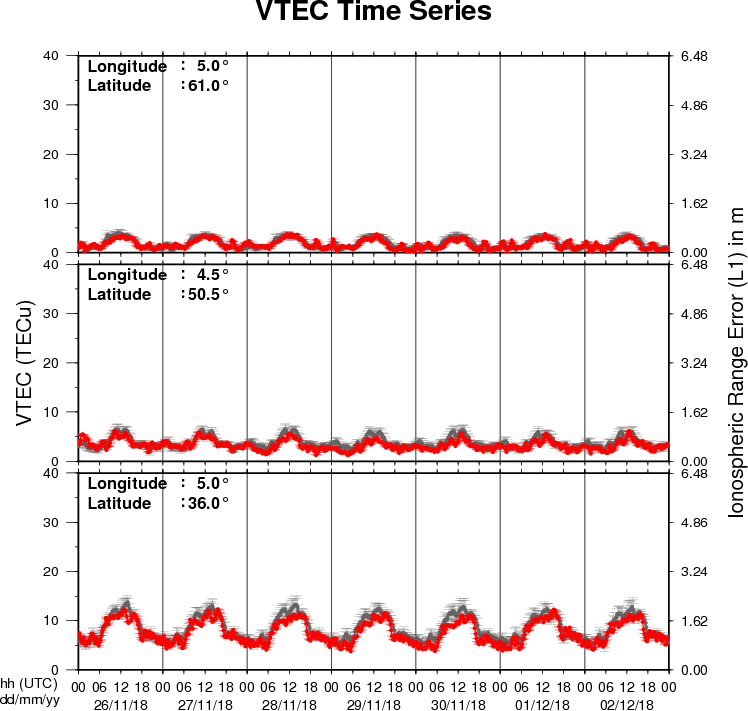
The figure shows the time evolution of the Vertical Total Electron Content (VTEC) (in red) during the last week at three locations:
a) in the northern part of Europe(N61°, 5°E)
b) above Brussels(N50.5°, 4.5°E)
c) in the southern part of Europe(N36°, 5°E)
This figure also shows (in grey) the normal ionospheric behaviour expected based on the median VTEC from the 15 previous days.
The VTEC is expressed in TECu (with TECu=10^16 electrons per square meter) and is directly related to the signal propagation delay due to the ionosphere (in figure: delay on GPS L1 frequency).
The Sun's radiation ionizes the Earth's upper atmosphere, the ionosphere, located from about 60km to 1000km above the Earth's surface.The ionization process in the ionosphere produces ions and free electrons. These electrons perturb the propagation of the GNSS (Global Navigation Satellite System) signals by inducing a so-called ionospheric delay.
See http://stce.be/newsletter/GNSS_final.pdf for some more explanations ; for detailed information, see http://gnss.be/ionosphere_tutorial.php
